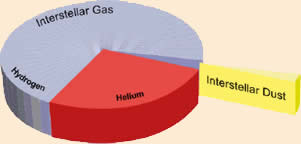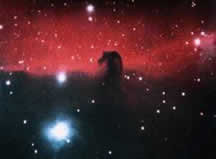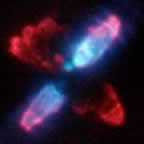Simply put, the interstellar medium is the material which fills the space between the stars. Many people imagine outer space to be a complete vacuum, devoid of any material. Although the interstellar regions are more devoid of matter than any vacuum artificially created on earth, there is matter in space. These regions have very low densities and consist mainly of gas (99%) and dust. In total, approximately 15% of the visible matter in the Milky Way is composed of interstellar gas and dust.
 Approximately 99% of the interstellar medium is composed of interstellar gas, and of its mass, about 75% is in the form of hydrogen (either molecular or atomic), with the remaining 25% as helium. The interstellar gas consists partly of neutral atoms and molecules, as well as charged particles, such as ions and electrons. This gas is extremely dilute, with an average density of about 1 atom per cubic centimeter. (For comparison, the air we breathe has a density of approximately 30,000,000,000,000,000,000 molecules per cubic centimeter.) Even though the interstellar gas is very dilute, the amount of matter adds up over the vast distances between the stars. The interstellar gas is typically found in two forms:
Approximately 99% of the interstellar medium is composed of interstellar gas, and of its mass, about 75% is in the form of hydrogen (either molecular or atomic), with the remaining 25% as helium. The interstellar gas consists partly of neutral atoms and molecules, as well as charged particles, such as ions and electrons. This gas is extremely dilute, with an average density of about 1 atom per cubic centimeter. (For comparison, the air we breathe has a density of approximately 30,000,000,000,000,000,000 molecules per cubic centimeter.) Even though the interstellar gas is very dilute, the amount of matter adds up over the vast distances between the stars. The interstellar gas is typically found in two forms:
 The cold clouds of neutral or molecular hydrogen are the birthplace of new stars if they become gravitationally unstable and collapse. The neutral and molecular forms emit radiation in the radio band of the electromagnetic spectrum.
The cold clouds of neutral or molecular hydrogen are the birthplace of new stars if they become gravitationally unstable and collapse. The neutral and molecular forms emit radiation in the radio band of the electromagnetic spectrum.
The ionized hydrogen is produced when large amounts of ultraviolet radiation are released by hot newly-formed stars. This radiation ionizes the surrounding clouds of gas. Visible light is emitted when electrons recombine with the ionized hydrogen, which is seen as beautiful red colors of emission nebulae. Examples of emission nebulae are the Trifid Nebula or the Orion Nebula (seen in this photograph).
Interstellar dust is not like the dust that you might find under your bed; it is made of very different substances. These dust particles are extremely small, just a fraction of a micron across, which happens to be approximately the wavelength of blue light waves. The particles are irregularly shaped, and are composed of silicates, carbon, ice, and/or iron compounds.
 When light from other stars passes through the dust, a few things can happen. If the dust is thick enough, the light will be completely blocked, leading to dark areas. These dark clouds are known as dark nebulae. The Horsehead Nebula, seen to the left, is an example of this.
When light from other stars passes through the dust, a few things can happen. If the dust is thick enough, the light will be completely blocked, leading to dark areas. These dark clouds are known as dark nebulae. The Horsehead Nebula, seen to the left, is an example of this.
Light passing through a dust cloud may not be completely blocked, although all wavelengths of light passing through will be dimmed somewhat. This phenomenon is known as extinction. The extinction is caused by the light being scattered off of the dust particles out of our line of sight, preventing the light from reaching us. The amount that the light is dimmed depends upon a few factors, including the thickness a nd density of the dust cloud, as well as the wavelength (color) of the light.
 Because of the size of the dust particles, scattering of blue light is favored. Therefore, less of the blue light reaches us, which means that the light that reaches us is more red than it would have been without the interstellar dust. This effect is known as interstellar reddening
. (Note that this is not the same thing as redshift, which is due to the effects of relative movement between a light source and its receiver.) This process is similar to those that make the sun red at sunset. (To see an explanation of extinction and interstellar reddening that is more mathematical, please visit this site.) In turn, a dust cloud that is illuminated by star light, when viewed from the side, appears blue, as in the close-up of the "Egg Nebula" seen at right. This is similar to the blue sky we see, which is produced by sunlight scattered by the Earth's atmosphere.
Because of the size of the dust particles, scattering of blue light is favored. Therefore, less of the blue light reaches us, which means that the light that reaches us is more red than it would have been without the interstellar dust. This effect is known as interstellar reddening
. (Note that this is not the same thing as redshift, which is due to the effects of relative movement between a light source and its receiver.) This process is similar to those that make the sun red at sunset. (To see an explanation of extinction and interstellar reddening that is more mathematical, please visit this site.) In turn, a dust cloud that is illuminated by star light, when viewed from the side, appears blue, as in the close-up of the "Egg Nebula" seen at right. This is similar to the blue sky we see, which is produced by sunlight scattered by the Earth's atmosphere.
 Aside from passing through, or being blocked from passing through, interstellar dust, light may also be reflected from the clouds of dust. This is seen as a reflection nebula, as is seen in the lower left corner of the Horsehead Nebula image as a bright spot. A reflection nebula is a region of dusty gas surrounding a star where the dust reflects the starlight, making it visible to us. The picture at left was taken by the Hubble Space Telescope, and is of NGC 1999, a nebula in the constellation Orion. (You can read the press release that accompanies the picture on the HST site.)
Aside from passing through, or being blocked from passing through, interstellar dust, light may also be reflected from the clouds of dust. This is seen as a reflection nebula, as is seen in the lower left corner of the Horsehead Nebula image as a bright spot. A reflection nebula is a region of dusty gas surrounding a star where the dust reflects the starlight, making it visible to us. The picture at left was taken by the Hubble Space Telescope, and is of NGC 1999, a nebula in the constellation Orion. (You can read the press release that accompanies the picture on the HST site.)